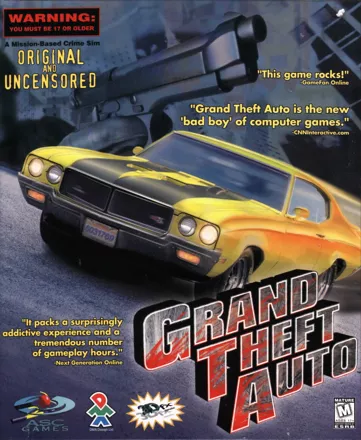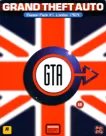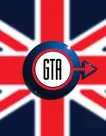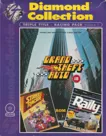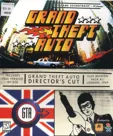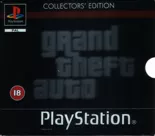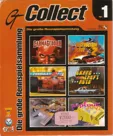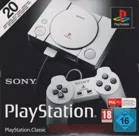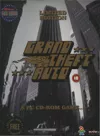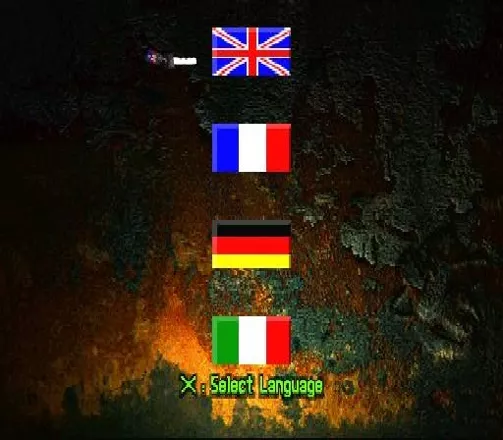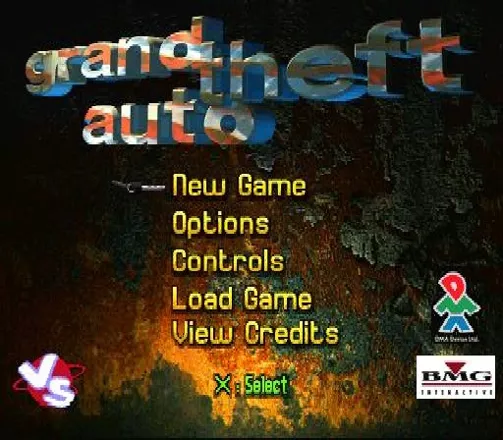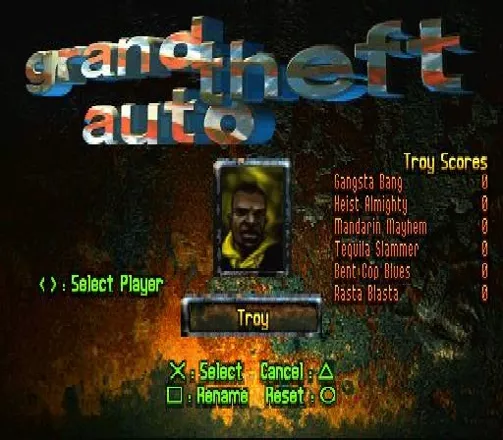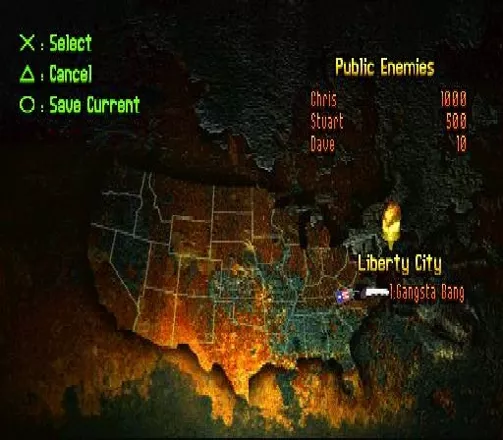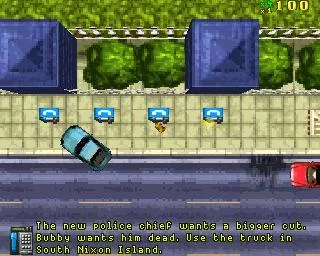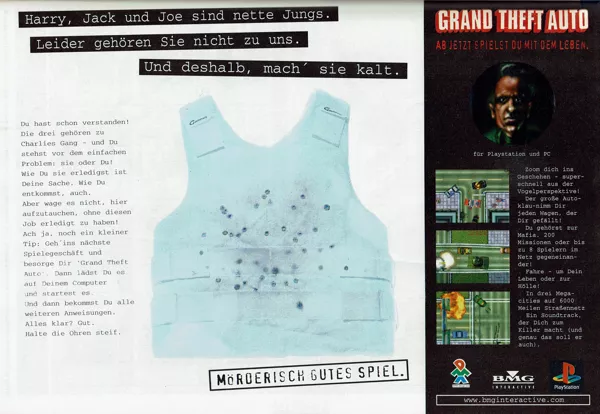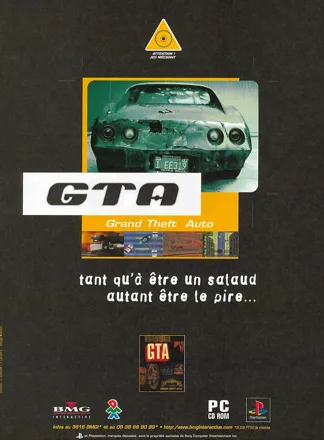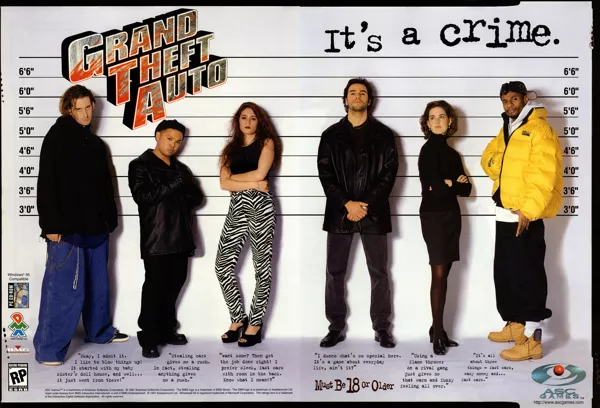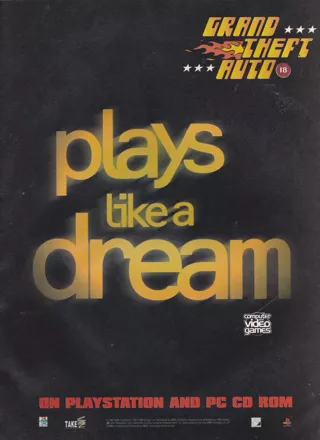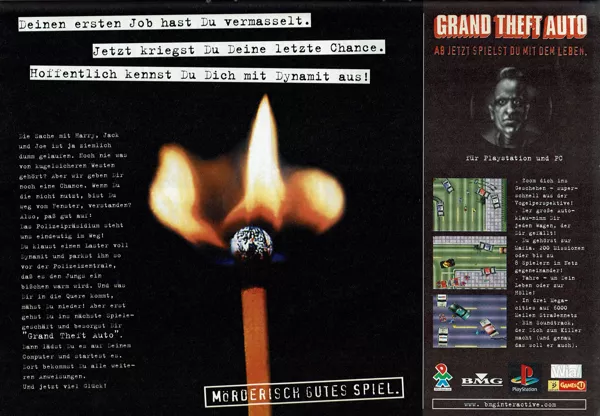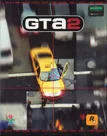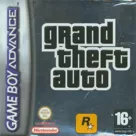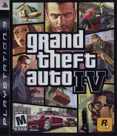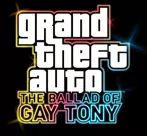Grand Theft Auto
Description official descriptions
In Grand Theft Auto, the player takes the role of a small-time criminal trying to make it big with the mob. Stealing cars, doing jobs for the gangsters and behaving generally anti-social are the way to success.
The action moves through six levels spread over three different cities, each based on a real US city: Liberty City (based on New York City), San Andreas (based on San Francisco) and Vice City (based on Miami). To finish a level, a certain score must be reached. Stealing cars and crashing into traffic, driving over pedestrians and killing cops all raise the score, but the big points are made through jobs. Answering phones or entering special cars brings mission assignments, from simple "ditch-a-hot-car" jobs to supporting bank robberies or carrying out assassinations. Completing a mission will raise the score substantially and also increase the score multiplier, so that completing the next felony will gain even more points.
Criminal behavior comes with a price of course: if policemen witness a crime, the player's wanted level rises. At the lowest level, a single police car might give chase, whereas at the highest level whole car squads hunt the player, the police set up roadblocks and shoot to kill. The only way to evade the cops is to find a respray shop and get a new paint job with new license plates. This costs money which is deducted from the score, however. But even dying or being arrested are not the end. The player has several lives, and ending up in jail simply results in being stripped of all weapons and armor and the score multiplier being lowered.
The entire action is viewed from a top-down perspective, which zooms out while driving a car, for a better overview at high speeds. The cities are many screens large and can be freely explored. Crates are scattered over the cities, which might include weapons (from pistols to rocket launchers), armor or other bonus items: extra lives, police bribes (used to reduce the wanted level to zero) and get-out-of-jail-free cards (used to retain score multiplier and weapons when busted). Dozens of different vehicles are available for the taking, each with unique characteristics: a bus will handle very differently than a sports car.
Spellings
- 侠盗车手 - simplified Chinese spelling
- 俠盜獵車手 - traditional Chinese spelling
Groups +
- Console Generation Exclusives: PlayStation
- Games pulled from digital storefronts
- Genre: Open world / Free-roaming / Sandbox action and driving
- Grand Theft Auto series
- Physical Bonus Content: Poster
- Physical Bonus Content: World Map
- PlayStation Greatest Hits releases
- PlayStation Platinum Range releases
- Protagonist: Female (option)
- Protagonist: Gangster
- Setting: 1990s
- Sound Engine: AIL / Miles Sound System
- White Label releases
Screenshots
Promos
Videos
Add Trailer or Gameplay Video +1 point
See any errors or missing info for this game?
You can submit a correction, contribute trivia, add to a game group, add a related site or alternate title.
Credits (DOS version)
86 People · View all
| Team Leader | |
| Lead Programmer | |
| Lead Artist | |
| Programming | |
| Artwork | |
| Map Design and Mission Programming |
|
| Writers | |
| Music Written, Produced and Performed by | |
| Audio Programming | |
| Sound Effects | |
| [ full credits ] | |
Reviews
Critics
Average score: 75% (based on 56 ratings)
Players
Average score: 3.6 out of 5 (based on 291 ratings with 13 reviews)
The Good
For one thing it's funny- however, some of the jokes are of an adult nature so kids under the age of 15 probably shouldn't play it (they wouldn't get the jokes anyhow...) The cars act more realistically in this game than they do in some racing games! The controls are right on and the gameplay is great. And the graphics, although bad, make the game that much funnier!
The Bad
The graphics are pretty bad.
The Bottom Line
Don't worry about the graphics. This game isn't for people with 2 Ghz computers and GeForce 3's. This game's emphasis is on good fun and good humour- and it succeeds at both very well! Some of the content is either offensive, innapropriate, or both, so youngins beware!!!
Windows · by Ben Fahy (92) · 2001
The Good
The games of the Grand Theft Auto series have been called many things: from a despicable, filthy videogame that glorifies crime and violence, to a masterpiece of a young art form. I have been a firm proponent of the latter view ever since I first laid hands on the demo version of Grand Theft Auto in 1997.
While one must assume that its theme of urban crime and gang warfare has been a major reason for the commercial success of the series, and no doubt the high production quality of the titles has had a large impact as well, I am convinced that its real strengths lie deeper, and they are evident even in this very first installment. The reasons why Grand Theft Auto has become one of the longest-running and best-selling videogame franchises ever are to be found beneath the surface. In a time when game concepts and genres seemed to have been explored almost fully, its very mechanics established a new form of gameplay. Something that worked so well that it spawned not only a genre, but a new way of putting players into a game. And something that the players responded to so positively that the games’ elements have been often copied, but rarely matched – maybe because numerous imitators mistakenly assumed GTA’s success to stem from superficial aspects such as the violence, the obscenity, the grittiness, rather than its deeper qualities, thus coming up with a whole slew of mediocre “gangster” games instead of new, detailed, and open game worlds.
Starting out as a simple technology demo showing a zooming and scrolling top-down view of a 3-dimensional urban environment, the developers at DMA Design saw the possibility of using it to simulate a complete living city, and use it for a new game concept. Tentatively titled Race ‘n’ Chase, the idea was for players to take the role of a police officer hunting down criminals. As we all know, things didn’t quite work out that way. The developers figured that as a police officer, players would be bound to a lot of rules. For example, they would have to be punished for cutting a corner across the sidewalk, because it endangers innocent bystanders. This would have collided with the film-inspired, action-packed chase gameplay the developers were aiming for. Hence the decision was made to reverse the roles, and let players control a gangster outrunning the police force. Mob missions were added later as a means of giving the game events some structure and background, which would prove to become an increasingly central aspect for later parts of the series.
Thus from the get-go, the centre of the GTA concept was the living, detailed, simulated city environment. Vehicles rolling through the streets and obeying traffic rules, pedestrians walking the sidewalks, a working public transport system, and emergency services that would respond to the events in the city – this was always at the core of Grand Theft Auto. It is why most players report that they spend more time experimenting with the game world than actually completing missions. The conscious decision to use a realistic city scenario instead of something more fantastic or futuristic, as with most other games of the genre, was very important as well. Most players were familiar with the theme, they knew what driving a car in a city should feel like, and how the environment should react to extraordinary events. Some of the ideas were still a tad too ambitious for the time, but no other game before Grand Theft Auto had ever come as close to a realistic, open, densely detailed and simulated game world.
Apart from the two central ingredients of the open game world and the reactive simulation, the designers’ love for detail was another main aspect for GTA’s success. These supposedly unimportant elements mean a lot of effort on the developer’s side, but in the end it is a main reason for its longevity, and why players spend so much time in the game world. Instead of taking players by the leash and leading them through the game’s storyline, liberal exploration of every nook and cranny of the game world is rewarded with little extras or jokes. In this regard, Grand Theft Auto pales in comparison with its own sequels, but within its possibilities, the levels are diverse and interesting to move around in. Power-ups, nice backyards, hidden areas and secret missions keep the cities from getting boring all too quickly.
Finally, the concept of freedom of choice has been consistently implemented in the game’s actual storyline missions as well. Should players choose to accept a predefined mission, and there is no obligation to, they are given instructions on what needs to be done, not how to accomplish it. Thus, players can really take advantage of the open world, and all the possibilities it gives them. Players are free, even encouraged, to think outside the box and find their own solutions. Again, this means a lot of additional effort for the developers because of the huge number of situations they have to consider, but it pays off in terms of player enjoyment. Each GTA player can find their own way of completing certain missions, and develop their own strategies, hence ending up playing a quite individual game of GTA.
On to some more technical aspects, many players criticised the game's graphics on perspective. This might be a valid point on the Game Boy or even the PlayStation versions, as the low resolution and colour depth really do not fit a game of this scope that well. However, the true-colour and high-resolution PC version is a joy to look at. Although the city can look a little bit too blocky at times, the textures are nice to look at and the cities all have their own style and personality. The top-down view is a wonderful thing and suits the frantic chase gameplay well. Of course, I can also only praise the 60-minute original soundtrack.
The Bad
The camera movements could have profited from a little more tweaking. Too often, the car disappears behind a high building, or the zoom-out does not take place quickly enough, leading to unnecessary crashes because one cannot see far enough ahead.
The collision detection can be quite annoying. Unrealistic rebounds after crashing into buildings, the sometimes sudden and almost unpreventable explosions, and cars getting stuck in between buildings – these problems just happen far too often, and can lead to extreme frustration.
And finally, the lacking save system that has been so often criticised. I appreciate the fact that it makes the game more challenging. Too often, the "quick-save and quick-load" of newer games removes all the challenge, I for one can often not resist the temptation of this cheap strategy, even though it means I'll probably enjoy the game a little less. But given that a GTA level can take well over an hour to complete, the lack of a save feature is just impractical. I do not always have the time for a non-stop 2-hour gaming session, which often leads to me not booting up the game because I don't want to invest that kind of time. Make the player pay for saving the game, make it hurt, like in GTA2 where you have to spend quite some in-game money for activating the save feature. But don't just prevent players from interrupting their session. It's not nice.
The Bottom Line
I have spent a lot of time in Grand Theft Auto. I probably know the streets of Liberty City as well as those of my hometown. The game is technically "tidy", although arguably unspectacular. But like the good old days of videogames so many of us fondly remember, it is the gameplay that just won't let you go. After 12 years, I still regularly feel like revisiting this wonderfully designed and simulated city, and just drive around in it a little. It appeals to the primitive fascination that made me play with my Matchbox cars when I was a little younger. It appeals to my love of old Hollywood gangster movies and chase scenes. It has memorable characters and nasty, challenging missions. And it allows me to play the game the way I want to play it.
Finally, I would also like to assess the GTA concept from a very, very distant bird's eye view. Personally, I see two main directions future videogames will have to explore and help develop. On one hand, new ways of telling immersive and emotional stories – with the media no longer in its infancy, it is time to find ways of really appealing to people’s innermost feelings, of making truly “mature” games. It has happened with movies, and it will have to happen with interactive entertainment. It is important to keep an eye on experimental developments in this area – projects such as Heavy Rain come to mind. On the other hand, there is the mechanics of game world simulation. Game worlds have to be believable, and to be believable they must feel alive. Giving players freedom of choice and simulating a world that reacts according to their actions is central to the interactive element which sets games apart from other forms of entertainment. After decades of largely linear games, it is hard to imagine where this could take us. But one thing is for sure: wherever tomorrow’s non-linear games will take us, they will owe much of their heritage to that little development studio in Scotland, who in the mid-1990s re-defined what a game world can be.
DOS · by Daniel Saner (3517) · 2009
If you don't have a PS, buy one to play this game!
The Good
Where to begin, where to begin... Well, it is amazingly playable for a console game (as the gameplay is exactly the same as on the PC) - even I, a guy who shivers at the thought of having to play a game on anything except my trusty old '87 IBM keyboard, can spend hour upon hour in front of the TV playing this masterpiece. I read Tomer Gabels infavourable review of the PC version, and I must say that the problems he describes are exactly the reason I bought a video game console in the first place, and GTA runs just perfectly on a PlayStation - no getting stuck in walls, no jerky graphics, no problems whatsoever.
In addition to being perfectly programmed, GTA really has excellent presentation. The first game disc I've ever popped into my CD player, GTA has brilliant sound. Every time you step into a vehicle, a "radio" soundtrack starts playing, and even though it isn't always the sort of music I'd tune in to, it perfectly suits the gameplay, and I found myself hijacking pick-up trucks just to hear the country track with the part that goes "menfolk found their women scary, 'cause they were so big and hairy". And it ain't 'arf bad effect-wise, either!
Nice sound doesn't make a good game, but GTA has well designed levels, enough hidden surprizes, and a concept original enough to keep me hooked until I've finished it.
(And the graphics are great for a 97 PS game - nothing fancy, but functional.)
The Bad
Frankly, I will never be able to understand games (I understand the reason, I just don't understand why that reason should matter) where you cannot save at any given point. In the contemporary console style, GTA only lets you save in between levels (city maps, that is), and it's pretty darn frustrating to botch the one last mission you need to finish a city by, say, driving off the pier or being cornered by police without your handy SMG.
The Bottom Line
I would hate to think that anyone who owns a PlayStation hasn't played this game, as it's the most rewarding single-player console game I've ever played. The bad-ass atmosphere and great presentation just grip you from the start and keep you hooked 'til your fingers drop off (not an unlikely conclusion for a person with normal-sized hands, when playing with the PS controllers).
PlayStation · by Late (77) · 2001
Discussion
| Subject | By | Date |
|---|---|---|
| Weird bug: Endless chases | Daniel Saner (3517) | Oct 27, 2008 |
Trivia
1001 Video Games
Grand Theft Auto appears in the book 1001 Video Games You Must Play Before You Die by General Editor Tony Mott.
Brazilian ban
Grand Theft Auto was banned from stores in Brazil.
Cities
The game takes place in the cities Liberty City, Vice City and San Andreas. These cities are also the showplaces of the following 3D games of the series.
Cover
When Take-Two Interactive bought BMG Interactive, they re-released Grand Theft Auto in Europe with a different box art.
Development
The original concept for GTA was that the player was supposed to be the police and he had to go around catching car looters, robbers, gang members and so on. In the late design stages, the team argued among themselves that it would be better if the players role be reserved. After a heated battle they all agreed on reversing the players role.
Doubled player glitch
- Go to a bike, without weapons.
- Press Enter and hold Ctrl at the same time.
- Take the car behind and smash the bike.
- A copy of the player character will appear. Do not drive over him, or the main player character will die.
Freeware release
As a way of saying thank you to the many fans of the series, Rockstar released a freeware version of GTA on the official website, updated to support the latest operating systems and DirectX software. It was also released on Steam, but later pulled.
German version
When playing the game with German language settings, it is not possible to choose the female protagonists.
Police trick
The streets of GTA maintain a finite supply of police cars in the face of escalating crime levels (largely thanks to the singlehanded effort of the player); an ex-roommate discovered that if you can put aside the gratification at delivering the coup de grace, blowing up their vehicles, and instead leave the coppers with barely-functional, heavily-damaged wagons, you can move through traffic largely with impunity -- whenever a police presence would be triggered, instead of dashing to the scene of the crime in powerful cruisers they would stagger on to the screen in the same fleet of dented Chitty-Chitty Bang Bangs you mercifully spared.
Should the police cars blow up, the department appears to instantaneously replace the exploded car with a brand new one with everything in top condition; cultivate their deprivation, however, and you can cause the entire force to limp along while you cruise by in the fastest ride that you can grab.
References
- In Vice City, you often see clothes that have been hung out to dry above alleyways and roads. Some of the blankets say "GTA" or "CM" - the initials of artist Craig Moore who worked on the game's textures.
- In San Andreas, one of the missions assigned to the player by Uncle Fu's crime syndicate is the killing of mob boss Don Traegeri. This is most certainly a reference to Don Traeger, who was involved in establishing publisher BMG Interactive in 1995.
References to the game
The cover of heavy metal band Megadeth's album Rude Awakening features vehicles from Grand Theft Auto.
Awards
- PC Gamer
- April 2000 - #50 (tied with Caesar III) in the Reader's All-Time Top 50 Games Poll
Information also contributed by Daniel Saner, Itay Shahar, Kartanym, Karthik KANE, PCGamer77, Pseudo_Intellectual, Steve . and Zovni
Analytics
Related Sites +
-
DMA Design LTD – Grand Theft Auto 1 Design Document
A 1995 design doc for the game (back when it was still Race'n'Chase). -
GTA at GTAGaming
Information site about all things GTA. -
Grand Theft Auto
Official game website -
IGCD Internet Game Cars Database
Game page on IGCD, a database that tries to archive vehicles found in video games. -
Rockstar Classics: Free Downloads!
The GTA game available as a free download from the developer's website (328 Mb).
Identifiers +
Contribute
Are you familiar with this game? Help document and preserve this entry in video game history! If your contribution is approved, you will earn points and be credited as a contributor.
Contributors to this Entry
Game added by robotriot.
Game Boy Color added by Brolin Empey. PlayStation added by Grant McLellan.
Additional contributors: Erwin Bergervoet, Unicorn Lynx, Apogee IV, Paranoid Opressor, Sciere, Havoc Crow, DreinIX, Paulus18950, Cantillon, Patrick Bregger, Plok, Victor Vance, FatherJack.
Game added November 12, 1999. Last modified February 7, 2025.


